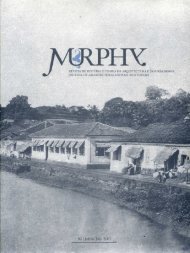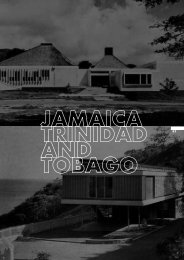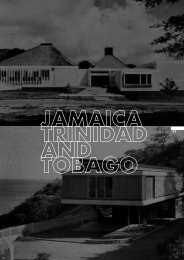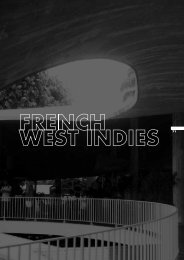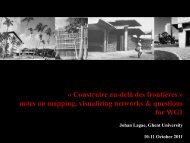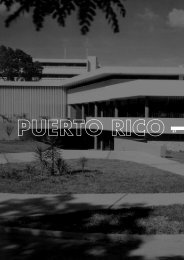Guadeloupe : The Modern Transition
Guadeloupe : The Modern Transition
Guadeloupe : The Modern Transition
You also want an ePaper? Increase the reach of your titles
YUMPU automatically turns print PDFs into web optimized ePapers that Google loves.
<strong>Guadeloupe</strong>,<br />
the modern transition<br />
CHRISTIAN GALPIN<br />
Asking the question of modern architecture in <strong>Guadeloupe</strong> amounts<br />
to examining the transition that affected this ‘old French colony,’ which<br />
became in 1946 a French department (administrative division), just like<br />
her continental sister Guyana and her other insular sister Martinique.<br />
80<br />
AT THE TURN of the twentieth century, architecture and<br />
town planning become subjects of first importance<br />
within the French colonial empire. Used to promote the<br />
colonial undertaking, in particular via Fair pavilions,<br />
architecture and town planning are duty-bound to express<br />
its ‘civilizing mission.’<br />
Thus, the colonial or World Fairs, and the other<br />
celebrations of France’s presence outside its geographic<br />
boundaries, showcases of the colonial undertaking,<br />
partake in the assertion of France’s place in the entente<br />
among the Western colonial powers. <strong>The</strong>se demonstrations<br />
are also authentic exercises in ‘colonial narcissism,’<br />
meant to express within the country itself the nation’s<br />
greatness. 1<br />
AS EARLY AS THE 1930s the first expressions of modern<br />
architecture markedly contributed to the development of<br />
landscapes and life styles, but the most important<br />
changes started in the 1960s. As a result the years<br />
between 1929 and 1960 can be considered a period of<br />
‘welding’ during which learned architecture contrived to<br />
blend in with the vernacular.<br />
THE INTENSITY of this ‘crossbreed’ relationship tended to<br />
weaken as the penetration of the modern movement and<br />
international style increased. Herein, the expression<br />
“international style,” coined by Henry-Russell Hitchcock<br />
and Philip Johnson in 1932, is used to describe the<br />
architecture and formal options that were carried out in<br />
Fig. 1. Ali Tur, Saint-André de Morne-à-l’Eau church, main façade, circa 1935. This church was listed on the additional register of historical places<br />
© L’Architecture d’Aujourd’hui 3 (March 1936)<br />
Docomomo N°33<br />
September 2005



